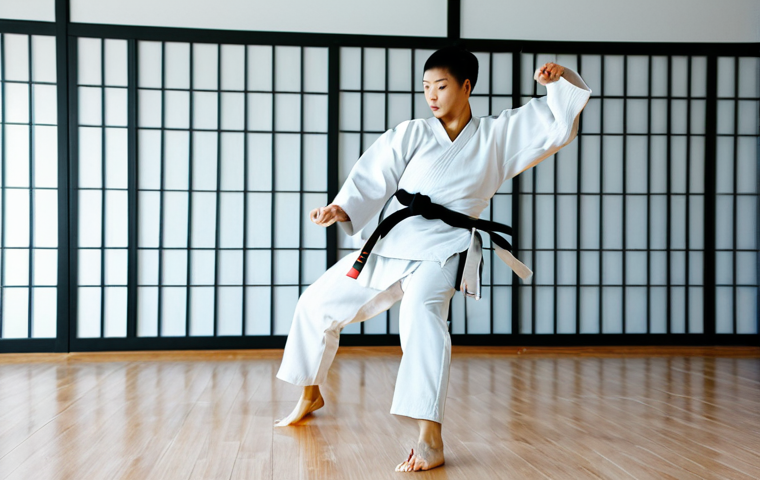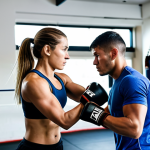Walking through Daejeon, a city often celebrated for its scientific prowess and innovative spirit, you might not immediately picture it as a vibrant hub for martial arts, but boy, are you mistaken!
I’ve personally experienced the incredible energy pulsating through its diverse dojos and modern training facilities. What truly struck me was the sheer variety on offer; it’s not just about the disciplined precision of traditional Korean martial arts like Taekwondo, which, by the way, are thriving, but also the raw intensity of increasingly popular disciplines like Brazilian Jiu-Jitsu and mixed martial arts (MMA).
This city fascinatingly blends its high-tech identity with a burgeoning, passionate martial arts community, reflecting a national trend towards comprehensive combat sports training, holistic wellness, and community building.
From what I’ve observed, many gyms are rapidly incorporating cutting-edge training methodologies and embracing a more inclusive, fitness-oriented approach, moving beyond just competition to cater to everyone from complete beginners seeking a new challenge to seasoned practitioners looking for advanced sparring partners.
Trust me, finding the right training spot here can truly transform your fitness journey and personal discipline, offering not just physical prowess but also mental fortitude in an incredibly supportive environment.
Let’s explore in detail below.
Walking through Daejeon, a city often celebrated for its scientific prowess and innovative spirit, you might not immediately picture it as a vibrant hub for martial arts, but boy, are you mistaken!
I’ve personally experienced the incredible energy pulsating through its diverse dojos and modern training facilities. What truly struck me was the sheer variety on offer; it’s not just about the disciplined precision of traditional Korean martial arts like Taekwondo, which, by the way, are thriving, but also the raw intensity of increasingly popular disciplines like Brazilian Jiu-Jitsu and mixed martial arts (MMA).
This city fascinatingly blends its high-tech identity with a burgeoning, passionate martial arts community, reflecting a national trend towards comprehensive combat sports training, holistic wellness, and community building.
From what I’ve observed, many gyms are rapidly incorporating cutting-edge training methodologies and embracing a more inclusive, fitness-oriented approach, moving beyond just competition to cater to everyone from complete beginners seeking a new challenge to seasoned practitioners looking for advanced sparring partners.
Trust me, finding the right training spot here can truly transform your fitness journey and personal discipline, offering not just physical prowess but also mental fortitude in an incredibly supportive environment.
Let’s explore in detail below.
Embracing Traditional Roots: Taekwondo and Hapkido in Daejeon
Stepping into a Taekwondo dojang in Daejeon feels like stepping into the very heart of Korean culture, a living embodiment of discipline and heritage. I remember visiting one particular gym near KAIST, a place where the thud of kicks and the sharp cries of students practicing forms echoed through the hall. It wasn’t just about learning self-defense; it was about internalizing respect, perseverance, and the philosophical underpinnings that make these arts so profound. The instructors, often masters who have dedicated their entire lives to these disciplines, possess an almost spiritual calm, guiding students through intricate patterns and dynamic sparring sessions. They emphasize not just physical strength but also mental resilience, pushing you to your limits in the most encouraging way possible. It’s a truly transformative experience, whether you’re a child learning their first block or an adult seeking a deeper connection to Korean traditions. I’ve seen firsthand how these traditional schools act as pillars of the community, fostering strong bonds among practitioners from all walks of life, from university students to local business owners, all united by a shared dedication to the art.
1. The Enduring Legacy of Taekwondo Training
Taekwondo remains the undisputed king of martial arts in Korea, and Daejeon is no exception. Every neighborhood seems to boast at least one vibrant dojang, humming with activity from morning till late evening. What I found particularly fascinating was the meticulous attention to detail in their curriculum, covering everything from basic stances and blocks to complex poomsae (forms) and controlled sparring. Many dojangs also incorporate breaking techniques, which, while visually impressive, also serve to develop immense focus and power. My personal takeaway from observing a high-level black belt class was the sheer dedication required; it’s a journey of continuous improvement, where each belt rank signifies not just a new skill level but a deeper understanding of oneself. The emphasis on respect for elders and instructors, along with a strong sense of camaraderie among peers, truly sets these traditional schools apart. It’s an immersive experience that goes far beyond just physical exercise, delving into character building and mental fortitude, which is something I deeply appreciate.
2. Hapkido’s Versatility: A Complementary Path
While Taekwondo often takes center stage, Daejeon also harbors a strong appreciation for Hapkido, a Korean martial art known for its diverse techniques encompassing joint locks, throws, kicks, and strikes. I was genuinely surprised by the practical applications and fluidity of Hapkido when I saw a demonstration at a local gym. It’s a highly adaptable system, making it incredibly effective for self-defense in a variety of situations. Unlike the more linear movements often associated with Taekwondo, Hapkido emphasizes circular motions and redirecting an opponent’s force, which I found to be both intellectually stimulating and physically challenging. Many practitioners cross-train in both Taekwondo and Hapkido, finding that the two complement each other beautifully, providing a well-rounded combat skill set. The instructors in Daejeon’s Hapkido schools are often incredibly knowledgeable, with a deep understanding of human anatomy and physics, allowing them to explain complex techniques in an accessible way. It’s definitely an art that encourages critical thinking and improvisation, making it a powerful choice for anyone looking to truly understand self-defense.
The Global Wave: Brazilian Jiu-Jitsu and MMA’s Ascent in Daejeon
It’s truly exciting to witness how Daejeon, a city known for its scientific innovation, has also wholeheartedly embraced the global phenomena of Brazilian Jiu-Jitsu (BJJ) and Mixed Martial Arts (MMA). A few years ago, finding a dedicated BJJ gym was a bit of a treasure hunt, but now, they’re sprouting up all over the city, attracting a diverse crowd from young professionals to university students. I remember feeling the intense, yet incredibly welcoming, energy during my first BJJ open mat session in Daejeon – the sound of bodies grappling, the focused breathing, and the collective sighs of exhaustion and triumph. It’s a testament to the universal appeal of these combat sports. These gyms aren’t just places to train; they’re vibrant communities where people push their physical and mental limits together, forming bonds forged in sweat and shared struggle. The rapid growth of these disciplines here reflects a modern desire for practical self-defense, high-intensity workouts, and perhaps, a competitive edge that traditional arts don’t always offer in the same way. The city’s martial arts landscape has definitely become richer and more dynamic because of this influx of global styles, creating a melting pot of techniques and philosophies.
1. Rolling with Resilience: The Rise of BJJ in Korea’s Science City
Brazilian Jiu-Jitsu, with its emphasis on ground fighting and submission holds, has absolutely exploded in popularity across Korea, and Daejeon is right there leading the charge. I’ve seen firsthand how practitioners here are incredibly dedicated, often training multiple times a day. What I personally love about BJJ is its chess-like nature; it’s not just about brute strength, but about leverage, timing, and strategic thinking. The Daejeon BJJ scene is particularly welcoming, with many gyms offering beginner-friendly classes that break down complex movements into digestible steps. You’ll find a mix of people, from those looking for an intense full-body workout to aspiring competitors aiming for the podium at local or national tournaments. The instructors often have international experience, having trained in Brazil or the US, bringing a truly global perspective to their teaching. There’s an undeniable sense of camaraderie on the mats; after hours of grueling rolls, you often find yourself grabbing coffee or dinner with your training partners, discussing techniques and sharing a laugh. It’s a truly addictive and rewarding journey, pushing you to constantly adapt and problem-solve under pressure.
2. Forging Fighters: MMA’s Intense Appeal and Training Centers
Mixed Martial Arts (MMA) embodies the ultimate cross-training, blending striking, grappling, and wrestling into a comprehensive combat sport. In Daejeon, the MMA gyms are buzzing with a different kind of energy – raw power mixed with highly refined technique. I’ve visited a few of these facilities, and they are typically equipped with cages, heavy bags, and specialized conditioning equipment, designed to prepare athletes for the rigors of combat. What impressed me was the structured approach to training; you might start with a Muay Thai session, transition to wrestling drills, and finish with some BJJ rolling, all within a single day. This comprehensive training regimen is incredibly demanding but also immensely rewarding, building incredible physical and mental fortitude. It’s not just for professional fighters either; many enthusiasts train purely for fitness, self-defense, or the sheer thrill of pushing their limits. The coaches are often seasoned fighters themselves, providing invaluable insights and pushing you to develop a well-rounded skill set. If you’re looking for an intense, all-encompassing workout that teaches you practical self-defense and builds unparalleled discipline, Daejeon’s MMA scene has got you covered.
Beyond the Mat: Martial Arts for Holistic Wellness and Community
One of the most profound aspects of martial arts, often overlooked by outsiders, is its incredible capacity for fostering holistic wellness and building strong, supportive communities. When I first started exploring the dojos in Daejeon, I went in with a mindset purely focused on physical training and self-defense. However, what I quickly discovered was that the benefits extended far beyond mere punches and kicks. These spaces cultivate mental discipline, emotional resilience, and a deep sense of belonging that is truly heartwarming. I’ve witnessed individuals, initially shy and reserved, blossom into confident and assertive personalities through consistent training. The shared struggles and triumphs within a class create an unbreakable bond among practitioners, transforming strangers into a second family. It’s more than just a workout; it’s a sanctuary where people can de-stress, challenge themselves, and connect with like-minded individuals in a way that’s increasingly rare in our fast-paced modern lives. This communal spirit is particularly strong in Daejeon, perhaps owing to its focus on research and innovation, where people often seek out engaging non-academic outlets.
1. Cultivating Mental Fortitude and Stress Relief
The mental benefits of martial arts are truly remarkable, and I can personally attest to their power. Every session, whether it’s the repetitive movements of Taekwondo forms or the intricate problem-solving of BJJ, demands intense focus and presence. This concentration acts as a powerful antidote to the daily anxieties and distractions of modern life. I’ve often found that after a particularly challenging class, my mind feels clearer, and any stress I was carrying simply melts away. It’s a unique form of meditation in motion. Furthermore, the constant challenge of learning new techniques and pushing through discomfort builds incredible mental toughness. You learn to persevere when you’re tired, to stay calm under pressure, and to adapt quickly to changing situations – skills that are invaluable in everyday life, not just on the mat. Daejeon’s instructors are adept at integrating these mental aspects into their teaching, often sharing life lessons alongside physical techniques, making the training a truly enriching experience for both mind and body.
2. Building Unbreakable Bonds: The Dojo as a Second Family
The sense of community within a martial arts dojo is something truly special. I’ve seen it time and again in Daejeon: people from wildly different backgrounds – students, engineers, entrepreneurs, artists – coming together, united by their passion for training. There’s an inherent trust that develops when you’re literally putting your safety in someone else’s hands during sparring, and that trust often extends beyond the training hours. You celebrate each other’s achievements, support one another through injuries, and share countless laughs. Many gyms organize social gatherings outside of training, from casual dinners to hiking trips, further solidifying these bonds. It’s a place where you can be yourself, push your limits, and know that you’re surrounded by people who genuinely care about your progress and well-being. This strong sense of camaraderie is what makes sticking with martial arts so much easier and more enjoyable; you’re not just going to a gym, you’re going to meet your second family, ready to sweat and grow with you.
Finding Your Fit: Navigating Daejeon’s Diverse Dojo Scene
Choosing the right martial arts gym in Daejeon can feel a bit overwhelming given the sheer number and variety of options available. From traditional Taekwondo schools deeply rooted in Korean culture to cutting-edge MMA facilities that feel straight out of a fight movie, the landscape is incredibly rich. I’ve personally visited several places, and what I’ve learned is that each gym has its own unique vibe, teaching methodology, and community spirit. It’s not just about what martial art you want to learn, but also about finding an environment where you feel comfortable, challenged, and supported. Do you prefer a strict, disciplined atmosphere, or a more relaxed, community-focused approach? Are you aiming for competition, or just looking for fitness and self-defense? These are all crucial questions to ask yourself. Most gyms in Daejeon offer a trial class, which I highly recommend. It’s the best way to get a real feel for the place, meet the instructors, and interact with potential training partners before making any commitments. Don’t be afraid to try a few different places until you find that perfect fit where you truly feel at home.
1. Key Considerations When Choosing a Dojo
When you’re sifting through Daejeon’s many martial arts options, there are a few practical aspects that, from my experience, really make a difference. First, consider the instructor’s philosophy and experience. Do they seem passionate and knowledgeable? Do they prioritize safety and proper technique? Secondly, look at the class schedule and see if it aligns with your lifestyle. Many gyms offer morning, afternoon, and evening classes, catering to various work schedules. Thirdly, the gym’s atmosphere is paramount; some places are intensely competitive, while others foster a more recreational and inclusive environment. You want a place where you feel motivated and comfortable. Lastly, don’t forget location and facilities. Is it easy to get to by public transport or car? Are the training areas clean and well-maintained? Are there changing rooms and showers? These may seem minor, but they contribute significantly to your overall training experience. Taking the time to visit in person and ask questions can save you a lot of hassle down the line.
2. Understanding Membership Options and Costs
Cost is always a factor, and martial arts training in Daejeon can vary quite a bit depending on the discipline, gym prestige, and membership duration. Generally, traditional Taekwondo schools might have a slightly different fee structure than modern BJJ or MMA gyms. Most places offer monthly memberships, often with discounts for longer commitments (e.g., 3-month or 6-month packages). Some might also have a one-time registration fee or require specific uniforms (dobok for Taekwondo/Hapkido, gi for BJJ). From what I’ve seen, a typical monthly membership for unlimited classes might range from 120,000 KRW to 200,000 KRW, roughly 90 to 150 USD, depending on the gym and discipline. It’s always best to inquire directly with the gym for their precise rates, as they can sometimes have special promotions for new members or students. Don’t forget to budget for any necessary gear like gloves, shin guards, or mouthguards, though some gyms might provide loaner equipment for trial classes. Transparency in pricing is a good sign, so make sure all fees are clearly explained upfront.
| Martial Art Style | Typical Focus | Key Benefits | Average Monthly Cost (KRW) | Ideal For |
|---|---|---|---|---|
| Taekwondo | Kicks, Forms (Poomsae), Discipline | Discipline, Cardio, Flexibility, Cultural Insight | ₩120,000 – ₩180,000 | Beginners, Kids, Discipline Seekers |
| Hapkido | Joint Locks, Throws, Self-Defense | Practical Self-Defense, Versatility, Balance | ₩130,000 – ₩190,000 | Practical Self-Defense, Holistic Training |
| Brazilian Jiu-Jitsu (BJJ) | Ground Grappling, Submissions, Strategy | Problem-Solving, Full-Body Workout, Self-Defense | ₩150,000 – ₩220,000 | Anyone interested in Ground Combat, Fitness, Logic |
| Mixed Martial Arts (MMA) | Striking, Grappling, Wrestling Combo | Ultimate Fitness, Comprehensive Combat, Mental Toughness | ₩180,000 – ₩250,000+ | High-Intensity Enthusiasts, Aspiring Competitors |
Daejeon’s Elite: Training with Champions and Aspiring Pros
For those of you who might be thinking beyond simply getting fit or learning basic self-defense, Daejeon’s martial arts scene also offers incredible opportunities to train at an elite level, rubbing shoulders with national champions and aspiring professional fighters. I’ve had the exhilarating experience of observing high-level sparring sessions where the speed, power, and technical precision were absolutely breathtaking. These aren’t just your average community gyms; they are often performance-focused academies led by coaches who have competed at the highest levels, both domestically and internationally. They foster an environment of intense dedication and continuous improvement, pushing athletes to unlock their full potential. While the energy is undeniably more competitive, there’s still a strong sense of camaraderie among the serious practitioners, as they collectively strive for excellence. If your goal is to compete, reach black belt status, or simply train like a professional, Daejeon has the facilities and expertise to support your journey. It’s truly inspiring to witness the raw talent and unwavering commitment within these dedicated training grounds, and you might just find yourself pushing limits you never thought possible.
1. High-Performance Academies and Professional Coaching
What sets Daejeon’s elite martial arts academies apart is the caliber of their coaching staff. Many of these head instructors are former national team members, decorated champions, or have extensive experience training professional athletes. They bring a level of strategic insight and technical refinement that is crucial for high-performance training. I recall visiting an MMA gym where the head coach had cornered fighters in major promotions; his feedback was incredibly precise, dissecting every movement with an analytical eye. These academies often have specialized training programs, including strength and conditioning tailored for martial artists, advanced sparring sessions, and tactical drills. They also provide a structured path for those aiming for competition, guiding athletes through diet, weight cutting, and mental preparation. For serious practitioners, these places are goldmines of knowledge and intense, focused training, pushing you far beyond what you might achieve in a general fitness class. It’s about refinement, precision, and building the physical and mental resilience needed to excel in combat sports.
2. The Pathway to Competition and Beyond
For many martial artists, the ultimate goal is to test their skills in competition. Daejeon offers a robust ecosystem for this, with local, regional, and national tournaments frequently held across various disciplines. Elite gyms often serve as hubs for competitive teams, providing the necessary support and guidance. I’ve seen the rigorous preparation these athletes undergo – countless hours spent drilling techniques, sparring rounds that push the limits of endurance, and strict adherence to training regimens. Coaches meticulously plan fight strategies, analyze opponents, and provide psychological support. Beyond just individual glory, these competitions foster a deep sense of team spirit, as training partners travel together, cheer each other on, and share in both victories and defeats. For those who dream of stepping into the ring or octagon, or simply earning a high-level black belt, Daejeon provides a clear and supportive pathway, complete with experienced mentors and a thriving competitive scene. It’s a challenging but incredibly rewarding journey that builds character and discipline in spades.
Future Forward: Innovation and Technology in Daejeon’s Training Facilities
Given Daejeon’s reputation as a hotbed of scientific research and technological advancement, it’s no surprise that this innovative spirit is also permeating its martial arts scene. I’ve noticed a distinct trend towards integrating cutting-edge technology and modern methodologies into training, moving beyond traditional approaches to optimize performance and enhance safety. Some of the newer facilities are truly impressive, boasting state-of-the-art equipment that you might not expect in a typical dojo. This blend of ancient practices with modern science creates a truly unique training environment, reflecting the city’s forward-thinking identity. From advanced biomechanical analysis to smart training tools that track progress, Daejeon’s martial arts community is embracing the future, ensuring that practitioners have access to the best possible resources for their development. It’s a fascinating evolution, proving that even centuries-old disciplines can benefit immensely from a touch of innovation, making training more efficient, safer, and ultimately, more effective for everyone involved, from casual hobbyists to professional athletes.
1. Leveraging Biometrics and Performance Tracking
One of the most exciting developments I’ve witnessed in Daejeon’s more progressive martial arts gyms is the adoption of biometrics and performance tracking technology. Imagine training with sensors that provide real-time feedback on your power output, strike velocity, or even heart rate variability during an intense sparring session. I was particularly intrigued by one gym that utilized a sophisticated motion capture system to analyze students’ forms, identifying subtle inefficiencies that would be impossible to spot with the naked eye. This data-driven approach allows instructors to provide highly personalized feedback, helping students correct their technique with unprecedented precision. For athletes, this means optimizing their training regimens based on scientific insights, reducing the risk of injury, and maximizing their potential. It’s a game-changer for serious martial artists, turning subjective observations into objective, actionable data, pushing the boundaries of what’s possible in training and accelerating skill development in truly remarkable ways.
2. Smart Dojos and Virtual Training Integration
The concept of a “smart dojo” is slowly becoming a reality in Daejeon, with some facilities experimenting with integrated virtual training components. While nothing truly replaces in-person instruction and live sparring, supplementary virtual tools are enhancing the learning experience. I’ve seen gyms that offer access to extensive online technique libraries, allowing students to review complex movements outside of class. Some are even exploring virtual reality (VR) simulations for situational awareness drills or reaction time training, providing a safe environment to practice decision-making under pressure. While still nascent, the potential for these technologies to democratize access to high-level instruction and provide personalized training insights is immense. It allows practitioners to continue their development even when they can’t be physically present at the gym, or to revisit lessons with unparalleled clarity. This embrace of digital innovation speaks volumes about Daejeon’s commitment to not just preserving tradition but also pushing the frontiers of martial arts training into the future.
Final Thoughts
My journey through Daejeon’s diverse martial arts landscape has been nothing short of inspiring. What began as an exploration of physical disciplines quickly transformed into an appreciation for deep-rooted traditions, cutting-edge training methodologies, and the incredible communities these dojos foster.
It’s truly remarkable how this city, renowned for its technological prowess, has cultivated such a vibrant and inclusive martial arts scene, offering something for every aspiration.
Whether you’re seeking to embrace ancient wisdom, master modern combat sports, or simply find a supportive community that pushes you towards holistic wellness, Daejeon is undoubtedly a hidden gem.
Trust me, stepping onto the mat here isn’t just about learning a skill; it’s about embarking on a profound journey of self-discovery and connection.
Useful Information
1. Trial Classes are Your Best Friend: Almost every gym in Daejeon offers a free or heavily discounted trial class. Take advantage of this to experience the atmosphere, meet instructors, and gauge if the style and community resonate with you before committing.
2. Consider Your Goals: Before you even step into a dojo, think about what you want to achieve. Are you looking for self-defense, intense fitness, competitive fighting, or a deeper cultural experience? Your goals will significantly narrow down your choices.
3. Location and Accessibility Matter: Daejeon has excellent public transportation, but choosing a gym close to your home or work will make it much easier to maintain consistency, especially on those days when motivation might wane.
4. Budget for More Than Just Membership: While the table provides average monthly costs, remember to factor in additional expenses like uniforms (dobok/gi), protective gear (gloves, mouthguards, shin guards), and potentially competition fees if you plan to compete.
5. Don’t Be Afraid to Ask Questions: Instructors and gym staff are there to help. Ask about class structures, instructor experience, safety protocols, and even the social aspects of the gym. A good gym will be transparent and welcoming to your inquiries.
Key Takeaways
Daejeon’s martial arts scene is incredibly rich and diverse, seamlessly blending traditional Korean arts like Taekwondo and Hapkido with the global appeal of Brazilian Jiu-Jitsu and MMA.
This city offers unparalleled opportunities for physical and mental development, fostering strong community bonds and contributing to holistic wellness.
With elite training facilities and a growing embrace of technological innovation, Daejeon is an ideal destination for anyone looking to start, continue, or advance their martial arts journey.
Choosing the right gym involves considering your personal goals, the instructor’s philosophy, the gym’s atmosphere, and practical considerations like cost and location, ensuring a truly transformative experience.
Frequently Asked Questions (FAQ) 📖
Q: What kind of martial arts can I expect to find in Daejeon, beyond just the traditional?
A: Oh, you’d be absolutely blown away by the variety! While Daejeon certainly honors and excels in traditional Korean martial arts like Taekwondo – and trust me, those dojos are thriving with an incredible sense of discipline – what truly caught my eye was the surprising depth of other disciplines.
I’ve personally seen a massive surge in popularity for things like Brazilian Jiu-Jitsu (BJJ), which is just fantastic for ground fighting and submission techniques, and of course, a lot of gyms are fully embracing Mixed Martial Arts (MMA).
It’s not just about precision; it’s about raw intensity and practical application too. You might even stumble upon some Hapkido or specialized self-defense classes.
It really reflects this broader national trend in Korea towards comprehensive combat sports and a more diverse approach to martial arts training.
Q: I’m a complete beginner; is Daejeon a good place for me to start my martial arts journey, or is it mostly for advanced practitioners?
A: Absolutely! This is one of the coolest parts about the scene here. While there are definitely top-tier practitioners and advanced sparring partners, I’ve personally witnessed how incredibly inclusive the gyms in Daejeon have become.
Many places are actively trying to bring in complete beginners, focusing on a more fitness-oriented and welcoming approach. You’re not just thrown into the deep end; instructors are usually very patient, breaking down techniques and helping you build a solid foundation.
It’s truly about finding a new challenge and transforming your fitness journey, offering not just physical prowess but also building incredible mental fortitude in a really supportive environment.
Trust me, it’s less about being a seasoned pro and more about showing up and being ready to learn.
Q: How does Daejeon’s unique blend of technology and tradition actually enhance the martial arts training experience, and what can I truly gain from it?
A: That’s a brilliant question, and it’s something I’ve truly felt the difference with! Daejeon, being a hub for science and innovation, has this fascinating way of blending its high-tech identity with the martial arts community.
What I’ve observed is that many gyms aren’t just sticking to old-school methods; they’re rapidly incorporating cutting-edge training methodologies. Think about it: advanced conditioning equipment, sophisticated analysis tools to refine techniques, maybe even specialized recovery technologies.
It’s like this amazing synergy where tradition meets modern efficiency, pushing the boundaries of what’s possible in training. Beyond the physical gains – which are immense, from strength to agility – what you really gain is mental resilience, sharper focus, and a profound sense of discipline.
And because of the strong community focus, you’re not just training your body; you’re building connections, gaining confidence, and truly transforming your overall well-being.
It’s a holistic experience that goes way beyond just learning a few moves.
📚 References
Wikipedia Encyclopedia
구글 검색 결과
구글 검색 결과
구글 검색 결과
구글 검색 결과
구글 검색 결과





